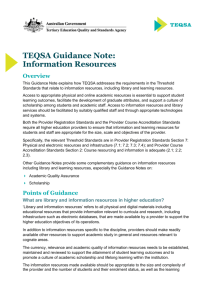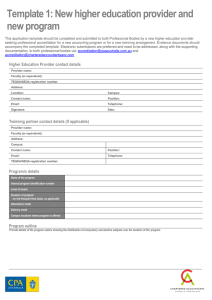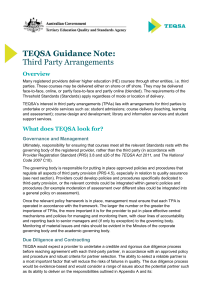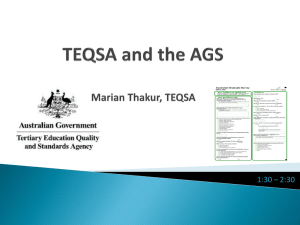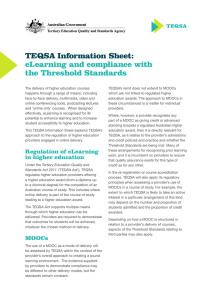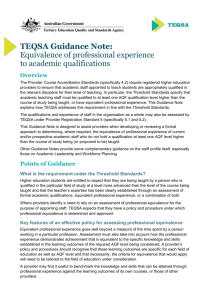Course Design (including Learning Outcomes and Assessment)
advertisement
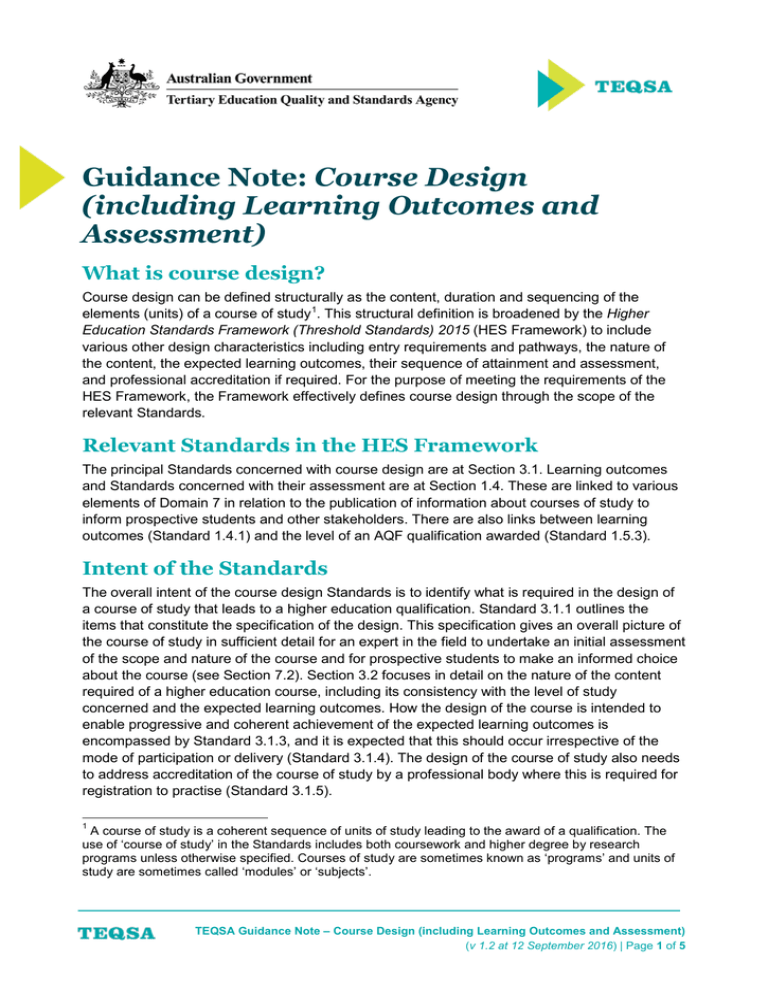
Guidance Note: Course Design (including Learning Outcomes and Assessment) What is course design? Course design can be defined structurally as the content, duration and sequencing of the elements (units) of a course of study 1. This structural definition is broadened by the Higher Education Standards Framework (Threshold Standards) 2015 (HES Framework) to include various other design characteristics including entry requirements and pathways, the nature of the content, the expected learning outcomes, their sequence of attainment and assessment, and professional accreditation if required. For the purpose of meeting the requirements of the HES Framework, the Framework effectively defines course design through the scope of the relevant Standards. Relevant Standards in the HES Framework The principal Standards concerned with course design are at Section 3.1. Learning outcomes and Standards concerned with their assessment are at Section 1.4. These are linked to various elements of Domain 7 in relation to the publication of information about courses of study to inform prospective students and other stakeholders. There are also links between learning outcomes (Standard 1.4.1) and the level of an AQF qualification awarded (Standard 1.5.3). Intent of the Standards The overall intent of the course design Standards is to identify what is required in the design of a course of study that leads to a higher education qualification. Standard 3.1.1 outlines the items that constitute the specification of the design. This specification gives an overall picture of the course of study in sufficient detail for an expert in the field to undertake an initial assessment of the scope and nature of the course and for prospective students to make an informed choice about the course (see Section 7.2). Section 3.2 focuses in detail on the nature of the content required of a higher education course, including its consistency with the level of study concerned and the expected learning outcomes. How the design of the course is intended to enable progressive and coherent achievement of the expected learning outcomes is encompassed by Standard 3.1.3, and it is expected that this should occur irrespective of the mode of participation or delivery (Standard 3.1.4). The design of the course of study also needs to address accreditation of the course of study by a professional body where this is required for registration to practise (Standard 3.1.5). 1 A course of study is a coherent sequence of units of study leading to the award of a qualification. The use of ‘course of study’ in the Standards includes both coursework and higher degree by research programs unless otherwise specified. Courses of study are sometimes known as ‘programs’ and units of study are sometimes called ‘modules’ or ‘subjects’. TEQSA Guidance Note – Course Design (including Learning Outcomes and Assessment) (v 1.2 at 12 September 2016) | Page 1 of 5 The Standards for learning outcomes require a provider to specify the learning outcomes for a course, including demonstrating their consistency with the field of education and level of qualification awarded. The Standards also require a provider’s specification of learning outcomes to be informed by national and international comparators, without specifying how a provider chooses to achieve this requirement. The Standards require achievement of different classes of learning outcomes (see Standard 1.4.2) including specific, generic, employmentrelated and life-long learning outcomes, and that all learning outcomes are assessed prior to completion of the course of study, irrespective of how and where they are assessed (Standard 1.4.4). Methods of assessment also need to provide students with timely feedback on their progress towards achieving course learning outcomes (Standard 1.3.3). There is a specific requirement to demonstrate the appropriateness, fitness of purpose and effectiveness of all methods of assessment for all providers (Standard 1.4.3) and there is specific detail on the requirements for and assessment of learning outcomes for research training by higher degrees, if undertaken by a provider. Risks to Quality In addressing course design and learning outcomes, the HES Framework seeks to prevent a series of important risks to the quality, outcomes and reputation of higher education. Failure to adequately and publicly specify the design of a course inhibits comparisons of courses and informed choice by students. It also indirectly potentially diminishes the standing of Australian higher education if international comparisons cannot be made, as do learning outcomes that are not informed by international comparators. Failure to meet the requirements of the HES Framework leads to risks of learning outcomes and course designs not being fit for higher education, particularly in relation to the level of advanced inquiry involved, with a consequent degradation of qualifications. There is also a risk that learning outcomes are poorly defined or not defined at all, and that they may be narrowly focused rather than embracing specific, generic, employment-related and life-long learning outcomes as expected of contemporary higher education. Inadequate consideration of different modes of participation or delivery may lead to disadvantage for some individuals/cohorts. If the achievement and assessment of expected learning outcomes are not aligned for the course of study overall, there is a risk of learning outcomes not being achieved or not being adequately assessed, or of some outcomes being assessed excessively to the detriment of others that are given little attention or ignored. Insufficient diligence in selecting methods of assessment may result in invalid or otherwise unreliable assessment, to the extent that students may graduate who have not in fact achieved the learning outcomes of the course. TEQSA Guidance Note – Course Design (including Learning Outcomes and Assessment) (v 1.2 at 12 September 2016) | Page 2 of 5 What TEQSA will look for This part of the guidance note covers the full extent of the Standards, and corresponding evidence that TEQSA may require, in relation to course design, learning outcomes and assessment. For new applicants seeking initial registration and course accreditation, TEQSA will require evidence to be provided in relation to all relevant Standards. For existing providers, the scope of Standards to be assessed and the evidence required may vary. This is consistent with the regulatory principles in the TEQSA Act, under which TEQSA has discretion to vary the scope of its assessments and the related evidence required. In exercising this discretion, TEQSA will be guided by the provider’s regulatory history, its risk profile and its track record in delivering high quality higher education. TEQSA’s case managers will discuss with providers the scope of assessments and evidence required well ahead of the due date for submitting an application. The evidence required for particular types of application is available from the Application Guides on the TEQSA website. When providers apply to TEQSA for course accreditation, they are required to provide detailed course documentation. In other circumstances (i.e. if an issue arises outside the scope of a formal application) TEQSA may be in a position to readily form a view on the basis of the publicly available information (required under Standard 7.2.2). Such an issue may also prompt a request for further information, which in turn may also be influenced by the provider’s previous record of meeting the requirements of the HES Framework in course design for cognate or different fields of education. Broadly speaking, the specification of the design of the course provided to TEQSA for a course accreditation application should allow a peer to form a view on the standing and quality of the course, and allow prospective students to compare comparable offerings from different providers. TEQSA requires that a provider be able to demonstrate that the content and learning activities of the course are of a sufficiently advanced level and otherwise appropriate to higher education, and are consistent with the field of education and the level of qualification involved. TEQSA will probe these aspects intensively in relation to the requirements of Standards 3.1.2 and 3.1.3. A provider may wish to advance credible national or international comparators in support of the course design (note that this is required for learning outcomes at Standard 1.4.1). Reference may also be made to the specifications of the AQF for the level of qualification concerned. In the case of ‘nested’ course designs, TEQSA will pay particular attention to entry and exit pathways and to the integrity of course design and learning outcomes for each exit point. Where the provider’s intention is to offer a course of study in different locations or by different modes of participation or delivery, TEQSA will need to be satisfied that the design of the course is such that students have equivalent opportunities to achieve the expected learning outcomes irrespective of their mode of participation. As for external accreditation of the course by a professional body (Standard 3.1.5), providers are encouraged to discuss this with their TEQSA TEQSA Guidance Note – Course Design (including Learning Outcomes and Assessment) (v 1.2 at 12 September 2016) | Page 3 of 5 case manager as early as practicable to explore opportunities for harmonisation and synergies between the processes. Just as TEQSA will be concerned that a course of study and its content are fit for higher education, it will be similarly diligent in relation to the nature, quality and level of the expected learning outcomes for the course (Standards 1.4.1-1.4.2). This will include an assessment of the credibility of comparators advanced by the provider (Standard 1.4.1) and may involve expert/peer review. Similarly, TEQSA will wish to be satisfied that the methods of assessment of learning outcomes that are used throughout the course are credibly capable of valid assessment of the various outcomes concerned for the level of qualification offered (see also Standard 1.5.3). The Standards require that all specified learning outcomes are assessed before completion of the course of study (Standard 1.4.4) and that progressive and coherent achievement of learning outcomes is planned in the design of the course (Standard 3.1.3). TEQSA will expect some clear information demonstrating where course learning outcomes are taught, practised and assessed, whether at unit level or at course level (e.g. via a ‘capstone’ assessment and/or an assessment against a set of occupational or professional standards) or a combination of these (Standard 1.4.4). TEQSA may require an appropriate demonstration that the learning outcomes that are assessed at individual unit level (and/or within a capstone unit) reasonably demonstrate achievement of overall course learning outcomes on graduation. The Standards also require that any grades awarded reflect the level of student attainment (Standard 1.4.3). TEQSA will expect providers to be able to advance credible evidence (such as moderation exercises, peer reviews, benchmarking studies) that will satisfy TEQSA in this respect. For those providers that offer research training by higher degrees, TEQSA will need to be satisfied that the additional requirements for the specification and assessment of learning outcomes for research training are met (Standards 1.4.5-1.4.7). This may involve an assessment of the relevant policies and procedures governing assessment for research degrees, and their implementation, as exemplified by assessment of actual reports from examiners for a sample of relevant assessments. The details of this process would be arranged in consultation with the provider’s case manager at TEQSA. Scope of assessments If, as a result of looking in detail at the provider’s capabilities in course design and assessment of learning outcomes, TEQSA is satisfied that the provider’s processes meet the requirements of the HES Framework and that there is evidence of continuing sustainability and effectiveness of these processes, this may allow TEQSA to reduce its evidence requirements for other Standards and/or for subsequent regulatory activities for other courses of study. On the other hand, if concerns are raised in relation to the provider’s capabilities, this may require TEQSA to probe the design and assessment of other courses in more detail. TEQSA Guidance Note – Course Design (including Learning Outcomes and Assessment) (v 1.2 at 12 September 2016) | Page 4 of 5 Resources and references Australian Qualifications Framework Council (2013), Australian Qualifications Framework Second Edition January 2013, <http://www.aqf.edu.au/>. FLIPCurric website, <http://flipcurric.edu.au/>. Office for Learning and Teaching project, Assuring Graduate Capabilities, <http://assuringgraduatecapabilities.com/>. Office for Learning and Teaching, Assuring Learning, <http://www.assuringlearning.com/> Office for Learning and Teaching Resource Library 2, <http://www.olt.gov.au/resources/goodpractice>. Publications developed by the Assessing and Assuring Graduate Learning Outcomes Project, <http://www.itl.usyd.edu.au/projects/aaglo/summaries.htm>. Quality Assurance Agency (2014), UK Quality Code for Higher Education 3, Chapter B1: Programme Design, Development and Approval, <http://www.qaa.ac.uk/AssuringStandardsAndQuality/quality-code/Pages/default.aspx>. TEQSA (2016), Explanations of terms in Part A of the HES Framework 2015, <http://www.teqsa.gov.au/explanations-hes-framework-terms>. Version # Date Key changes 1.0 13 April 2016 Made available as beta version for consultation. 1.1 19 August 2016 Incorporated feedback from consultation, including clarification of what TEQSA will look for, elaboration of learning outcomes assessed at unit level, and an addition to the resources and references. 1.2 12 September 2016 Addition of additional reference Office for Learning and Teaching, Assuring Learning, <http://www.assuringlearning.com/> 2 This library contains a collection of higher education learning and teaching materials flowing from projects funded by the Commonwealth of Australia, including those from the Australian Learning and Teaching Council. 3 This document sets out expectations for providers of UK higher education. TEQSA Guidance Note – Course Design (including Learning Outcomes and Assessment) (v 1.2 at 12 September 2016) | Page 5 of 5
